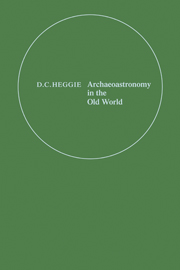Book contents
- Frontmatter
- Contents
- PREFACE
- LIST OF CONTRIBUTORS
- INVITED PAPERS
- CONTRIBUTED PAPERS
- A SURVEY OF THE BARBROOK STONE CIRCLES AND THEIR CLAIMED ASTRONOMICAL ALIGNMENTS
- OBSERVATIONS AT KINTRAW
- DECODING THE CALLANISH COMPLEX - A PROGRESS REPORT
- ASTRONOMY AND STONE ALIGNMENTS IN S.W. IRELAND
- STONE RINGS OF NORTHERN POLAND
- ASTRONOMICAL ORIENTATION OF NEOLITHIC SITES IN CENTRAL EUROPE
- STONE CIRCLE GEOMETRIES: AN INFORMATION THEORY APPROACH
- INVITED PAPER
- INDEX
ASTRONOMICAL ORIENTATION OF NEOLITHIC SITES IN CENTRAL EUROPE
Published online by Cambridge University Press: 05 November 2011
- Frontmatter
- Contents
- PREFACE
- LIST OF CONTRIBUTORS
- INVITED PAPERS
- CONTRIBUTED PAPERS
- A SURVEY OF THE BARBROOK STONE CIRCLES AND THEIR CLAIMED ASTRONOMICAL ALIGNMENTS
- OBSERVATIONS AT KINTRAW
- DECODING THE CALLANISH COMPLEX - A PROGRESS REPORT
- ASTRONOMY AND STONE ALIGNMENTS IN S.W. IRELAND
- STONE RINGS OF NORTHERN POLAND
- ASTRONOMICAL ORIENTATION OF NEOLITHIC SITES IN CENTRAL EUROPE
- STONE CIRCLE GEOMETRIES: AN INFORMATION THEORY APPROACH
- INVITED PAPER
- INDEX
Summary
Abstract. The orientations of more than 2200 finds covering linear pottery, corded ware and bell beaker are discussed. The azimuthal distribution is shown to be characteristic for each culture. Furthermore, the skeletons and/or graves were oriented towards the cardinal points rather than actual azimuths of the rising or setting sun. The accuracy of determinq true north is estimated to be of the order of 3. This can only be achieved by employing methods like the Indian circle. Thus a catalogue of minimal knowledge of geometry and astronomy may be derived. The anthropological data were used to construct a population curve.
Introduction
Since 1978, the Institutes of Astronomy and Prehistory of the Ruhr-University Bochum collaborated in an interdisciplinary project to investigate neolithic orientations. Data on over 2200 finds have been collected and prepared for electronic data processing. One of the aims was to establish a catalogue of minimal knowledge in geometry and astronomy in neolithic times. Initially, the well-documented Bohemian-Moravian bell beaker and corded ware cultures were selected, because in two previous papers U. Fischer (1953, 1956) showed their tendency for non-uniform orientation. Since both cultures terminate the neolithic epoch, in 1980 an early-neolithic culture – linear pottery – was added to the program. Due to the relatively homogeneous cultural pattern of linear pottery, data from a larger region were collected, ranging from Alsace to Slovakia.
- Type
- Chapter
- Information
- Archaeoastronomy in the Old World , pp. 225 - 230Publisher: Cambridge University PressPrint publication year: 1982
- 1
- Cited by



